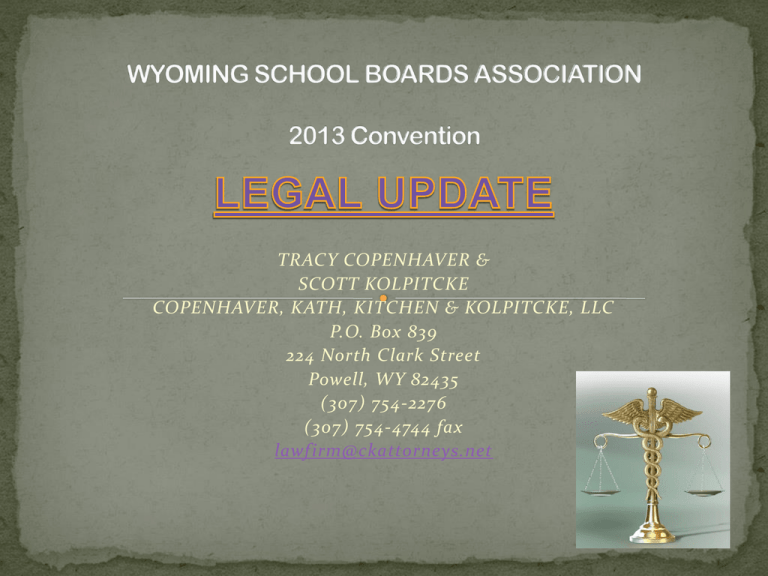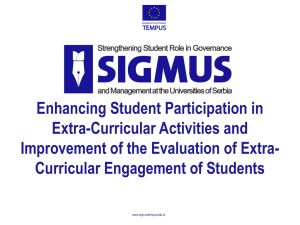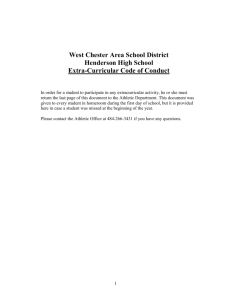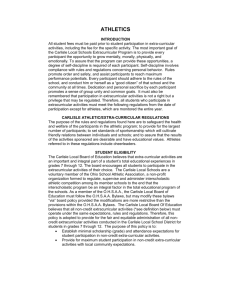
TRACY COPENHAVER &
SCOTT KOLPITCKE
COPENHAVER, KATH, KITCHEN & KOLPITCKE, LLC
P.O. Box 839
224 North Clark Street
Powell, WY 82435
(307) 754-2276
(307) 754-4744 fax
lawfirm@ckattorneys.net
FAMILY EDUCATIONAL
RIGHTS AND PRIVACY ACT
• “Education Records”
• 20 U.S.C. §1232g(a)(4)(A)(i)
• 34 CFR 99.3
• “directly related to the student”
• “maintained by the educational agency or
institution or any party acting for the
agency”
“Record” means any information recorded in
any way, including, but not limited to,
handwriting, print, computer media, video or
audio tape, film, microfilm,
and microfiche.
34 CFR 99.3
• What’s not included:
• Sole possession notes
• Law enforcement unit
records
• “Directory” Information
Owasso Independent School District v. Falvo,
534 U.S. 426 (2002)
Student peer graded papers are not
“maintained” within the meaning of FERPA
Personally Identifiable Information includes, but is
not limited to—
(a) The student's name;
(b) The name of the student's parent or other family members;
(c) The address of the student or student's family;
(d) A personal identifier, such as the student's social security number, student
number, or biometric record;
(e) Other indirect identifiers, such as the student's date of birth, place of birth, and
mother's maiden name;
(f) Other information that, alone or in combination, is linked or linkable to a specific
student that would allow a reasonable person in the school community, who does not
have personal knowledge of the relevant circumstances, to identify the student with
reasonable certainty; or
(g) Information requested by a person who the educational agency or institution
reasonably believes knows the identity of the student to whom the education record
relates.
34 CFR 99.3
• Release of directory information
• 20 U.S.C. §1232g(a)(5)(B)
• Opt-out permitted
• Annual Notices
• Record of Release
Directory information means information
contained in an education record of a
student that would not generally be
considered harmful or an invasion of privacy
if disclosed.
34 CFR 99.3
Directory information includes, but is not limited to,
the student's name; address; telephone listing;
electronic mail address; photograph; date and
place of birth; major field of study; grade level;
enrollment status ( e.g., undergraduate or
graduate, full-time or part-time); dates of
attendance; participation in officially recognized
activities and sports; weight and height of members
of athletic teams; degrees, honors, and awards
received; and the most recent educational agency
or institution attended.
34 CFR 99.3
“These amendments specifically provide that
a school may safely provide what is termed
“directory information”—such personal facts
as name, address and telephone number—to
third parties without fear of having its Federal
funds withdrawn.”
Joint Statement in Explanation of the Buckley/Pell
Amendment
120 Cong. Rec. 39863 (December 13, 1974)
Any educational agency or institution making
public directory information shall give public
notice of the categories of information which it
has designated as such information with respect
to each student attending the school and shall
allow a reasonable period of time after such
notice has been given for a parent to inform the
institution or agency that any or all of the
information designated should not be released
without the parents’ prior consent.
“We determined awhile back that schools can, under
FERPA, choose an all or nothing approach with
directory information because in some school districts
it would be too cumbersome to keep track of the
directory information items that certain parents want
to opt out of or not. I know that some schools do do
that; I know that some schools do give them the
choice, but if a school says look, we can’t do it, we can
just have an opt in for everything or an opt out, that’s
perfectly fine under FERPA.”
§ 99.7 What must an educational agency or institution include in its
annual notification?
(a) (2) The notice must inform parents or eligible students that they have the
right to—
(i) Inspect and review the student's education records;
(ii) Seek amendment of the student's education records that the parent or
eligible student believes to be inaccurate, misleading, or otherwise in violation
of the student's privacy rights;
(iii) Consent to disclosures of personally identifiable information contained in
the student's education records, except to the extent that the Act and § 99.31
authorize disclosure without consent; and
(iv) File with the Department a complaint under §§ 99.63 and 99.64 concerning
alleged failures by the educational agency or institution to comply with the
requirements of the Act and this part.
(3)
The notice must include all of the following:
(i) The procedure for exercising the right to inspect and review education
records.
(ii) The procedure for requesting amendment of records under § 99.20.
(iii) If the educational agency or institution has a policy of disclosing education
records under § 99.31(a)(1), a specification of criteria for determining who
constitutes a school official and what constitutes a legitimate educational
interest.
(b) An educational agency or institution may provide this notice by any means
that are reasonably likely to inform the parents or eligible students of their
rights.
(1) An educational agency or institution shall effectively notify parents or eligible
students who are disabled.
(2) An agency or institution of elementary or secondary education shall
effectively notify parents who have a primary or home language other than
English.
Production of Student Records in Response
to Subpoena:
Under what conditions is prior consent not required to
disclose information?
(9)(i) The disclosure is to comply with a judicial order or
lawfully issued subpoena.
(ii) The educational agency or institution may disclose
information under paragraph (a)(9)(i) of this section only if
the agency or institution makes a reasonable effort to
notify the parent or eligible student of the order or
subpoena in advance of compliance, so that the parent
or eligible student may seek protective action.
Eligible student means a student who has
reached 18 years of age or is attending an
institution of postsecondary education.
When a student becomes an eligible student,
the rights accorded to, and consent required of,
parents under this part transfer from the parents
to the student.
34 CFR § 99.5
34 CFR § 99.4 What are the rights of parents?
“An educational agency or institution shall give full
rights under the Act to either parent, unless the agency
or institution has been provided with evidence that
there is a court order, State statute, or legally binding
document relating to such matters as divorce,
separation, or custody that specifically revokes these
rights”
Schools authorized to share without parental consent
student records with DFS case workers or other
representatives of the State or Tribal organizations who are
authorized to access student case plans. Typically this is
pursuant to a court order and frequently involves
establishment of an MDT. The law allows school district to
divulge confidential information to DFS or Tribal
organizations personnel only if the school receives
assurance that the educational record will not be disclosed
by such agency or organization except to an individual
authorized by that agency to address the student’s
educational needs and is authorized by the agency to
receive the information.
Get a letter of assurance.
A draft letter is available.
SURVEILLANCE CAMERAS:
Footage from surveillance cameras is generally not
an education record unless there is a specific
incident involving specific students, such as a
disciplinary infraction. In that instance, the U.S.
Dept. of Education’s Family Policy Compliance
Office determined that the parents of the involved
student may view the footage but would not be
permitted to receive a copy unless the parents of
the other involved students provided consent.
Consent from parents of students in the
background is not required.
Emails among staff discussing a student, including
discussions about his educational progress or program,
were not educational records subject to disclosure to
parents. In L.A. & M.A. vs. Tulane Co. Office of Education,
the Court ruled that in those instances only documents
placed in a student’s permanent file are considered
“maintained” and, as such, those not in the permanent file
were not educational records that had to be produced to
the parents.
GENDER IDENTITY
In November, Wyoming High School Activities
Association (WHSAA) approved first reading of Rule
6.8.0: Gender Identity Participation. Second reading
will be in February 2014.
The policy requires school districts to “be the first
point of determination for the student’s eligibility…”
The WHSAA policy states that the school may
consider the following in making its decision:
Gender identity from school registration records;
Medical documentation (hormonal therapy, sexual reassignment surgery, counseling, medical personnel,
etc.)
Balancing the effects the approval would have on the
individual and those other individuals that would be
affected by the change.
If a parent or the school disagrees with the decision,
that party can appeal to the WHSAA.
Schools will need to adopt a policy to determine who
will make these decisions, how they will make the
decisions, and what process they will use.
There may be other criteria in addition to those
identified in the WHSAA policy.
Mathis v. Fountain-Ft. Carson School District 8,
Colorado Division of Civil Rights decision, June 2013.
Mathis is NOT a court case, and is based on Colorado
law.
BUT – the discussion sheds light on the kind of
evidence boards may have to consider.
Facts: a 6-year-old/first grade student registered for
school as a boy, and the birth certificate shows he is a
boy.
As early as 18 months old, the child begins showing a
preference for female gender identity: feminine
clothing and toys. Between 4 and 6, began
articulating a belief that she was a girl, and became
vocal about her female gender identity.
The school eventually told the 1st grade teacher that
the student must use the boys bathroom.
Colorado Division of Civil Rights investigated the
complaint from the family, and found that the school
discriminated against the student on the basis of a
protected class: transgendered.
The school argued that they were trying to 1) protect
the student from harassment or bullying; and 2)
consider the effect on other students and parents.
“The [school]…cannot legally bar transgender students
from their statutory right to use the restroom of their
choice because of the school’s preoccupation with
situations which have not yet occurred or in order to
assuage the discomfort of parents.”
“Sex assignment at birth… is merely a category that a
child is placed in based on observable anatomy, and
does not take into consideration the psychological and
biological variations associated with the composition
of each person. Given the evolving research into the
development of transgender persons,
compartmentalizing a child as a boy or a girl solely
based on their visible anatomy, is a simplistic approach
to a difficult and complex issue.”
“The evidence demonstrates that socially, legally, and
medically the [student] is considered female.”
The school offered to let the student use the gender
neutral staff bathroom.
“This…is reminiscent of the ‘separate but equal’
philosophy, which revealed, at least in terms of
protected classes, that separate is very rarely, if ever,
equal.”
“Telling the [student] that she must disregard her
identity while performing one of the most essential
human functions constitutes severe and pervasive
treatment, and creates an environment that is
objectively and subjectively hostile, intimidating or
offensive.”
TRANSGENDER IS NOT A PROTECTED CLASS UNDER
FEDERAL LAW, OR WYOMING LAW
BUT:
-WHSAA IS ADOPTING POLICY ON TRANSGENDERED
STUDENTS; AND
-ON NOVEMBER 7, U.S. SENATE APPROVED BILL WHICH
WOULD MAKE TRANSGENDERED STATUS AND SEXUAL
ORIENTATION PROTECTED CLASSES UNDER FEDERAL
LAW. THE HOUSE OF REPRESENTATIVES LIKELY WILL
NOT AGREE (NOT THE LAW NOW)
WAIVER OF CONTINUING CONTRACT STATUS/TENURE
1. Teacher to administrator
2. Teacher to non-teaching position (i.e., counselor)
a. Voluntary resignation
b. Acknowledgment of continuing contract right and
very clear, express intent to voluntarily waive the
continuing contract/tenure right
c. Consideration for the waiver of the right
i. Lump sum payment (more than nominal)
ii. Increased salary or benefits
iii. Other benefits that go along with the new position
d.
e.
An opportunity to review and a recommendation to
consult with advisors, including attorneys.
In the event of litigation, the prevailing party is
entitled to recover all costs, expenses and attorney
fees.
Are the names of candidates for vacant positions
public information?
Are the applications submitted by candidates for
vacant positions public records?
Cheyenne Newspapers, Inc. Lee Newspapers, and the
Associated Press v. University of Wyoming, Second
Judicial District, Albany County, 2013.
The media sued UW seeking the names of the finalists
for the president of UW.
After a trial, in January 2013, the Court ruled in favor of
the media, ruling that the names of the finalists were
NOT confidential.
UW provided evidence that two or three of the
candidates would withdraw if their names were made
public.
The District Court held that UW failed to meet its
burden of proof that the public would suffer
“substantial harm or injury” if the names of the 15
finalists were released.
Legislative response to the Court’s decision: the
legislature amended W.S. 16-4-203(b)(vii) to allow UW
and the community colleges to maintain the
confidentiality of applications for the position of
president, all records relating to the search process,
and all records that could identify a candidate.
How does the legislative change affect school districts?
City of Laramie v. Raehal, Vitale and Cheyenne
Newspapers, Inc. d/b/a The Laramie Boomerang: This
case pertains to the confidentiality of records in a
personnel file.
June 25, 2013. U.S. Dept. of Education Civil Rights “Dear
Colleague” letter:
Academic Success of Pregnant and Parenting Students.
Clarification of specific requirements of Title IX
applicable to pregnant and parenting students,
including:
1.
It is illegal under Title IX for schools to exclude
pregnant students from participating in any part
of an educational program, including extracurricular activities.
•Schools may implement special instructional programs or
classes for pregnant students, but participation must be
completely voluntary on the part of the student. These
programs and classes must be comparable to those offered to
other students with regard to the range of academic, extracurricular and enrichment opportunities.
•A student who is pregnant or who has given birth may NOT
be required to submit medical certification for school
participation unless such certification is also required for all
other students with physical or emotional conditions
requiring the attention of a physician.
•
A school must excuse a student’s absences because of
pregnancy or childbirth for as long as the student’s
doctor deems the absences medically necessary.
When a student returns to school, she must be allowed to
return to the same academic and extra-curricular status as
before her medical leave began.
LOCAL PREFERENCE FOR PUBLIC BIDS
Western Wyo. Construction Co., Inc. v. Bd. of County
Commissioners of Sublette Co., Wyo., April 2013.
Two Wyoming resident contractors bid on a highway
construction project and the County Commissioners
elected to award the bid to the local contractor, even
though the local contractor’s bid was not the lowest bid.
The Appellant argued that W.S. §16-6-102(a) required
the Commissioners to award the contract to the
responsible, certified Wyoming resident making the
lowest bid.
The Wyoming Supreme Court, in Green River v.
deBernardi, affirmed the District Court decision that
the City’s policy of giving a 10% preference to local
businesses violated Wyoming public policy and the
statute.
The Supreme Court held in Western that the interpretation
given by the Court in deBernardi is inconsistent with clear
legislative intent and is therefore overruled.
The Commissioners asserted that neither the case nor
statute prohibits a county from exercising its discretion to
award a multi-million dollar contract to a local business in
an effort to assist the local economy, particularly when the
difference in the low bids is minimal.
The Supreme Court further held that W.S. §16-6-102 has
no application in awarding bids among Wyoming
residents, but rather, applies only in the context of
competing bids from a resident and a non-resident
contractor.
Summary judgment for the County reversed because the
record did not demonstrate where the funds came from to
pay for the project. One possibility was State funds
administered under W.S. §24-2-108 which applies to road
work and requires that “if the cost exceeds $200,000, the
contract must be awarded after public notice to the lowest
responsible bidder.”
The Court concluded it could not decide the matter until it
was determined where the money came from to pay for the
project and the appropriate provisions applicable to that
funding and the awarding of a bid.
MIRANDA WARNINGS
NC V. Commonwealth of Kentucky, 396 SW 3rd 852
( Sup. Ct. of Kentucky 2013):
ISSUE: Is a student entitled to the benefit of the
Miranda warnings before being questioned by a school
official in conjunction with a law enforcement officer,
the SRO, when he is subject to criminal charges?
In NC, the SRO removed a student from his classroom,
and took him to the assistant principal. The AP
questioned the student in the presence of the SRO (a
deputy sheriff).
At the end of the meeting, the AP told the student he
would be subject to school discipline. The SRO then
told the student he would be charged with a crime.
The Kentucky Supreme Court ruled that the student’s
admissions to the AP should be suppressed because he
had not been advised of his Miranda rights.
The Court’s ruling does NOT affect the school
disciplinary action (the expulsion). The Court’s ruling
meant that the student’s admission could not be used
to prosecute him in the criminal case.
The Court noted that the U.S. Supreme Court has
already found that Miranda warnings should be given
to juveniles in custody.
Even though the questioning was done by the assistant
principal, and not by the SRO, the Court noted that
other courts have found that people who are not law
enforcement may be treated as law enforcement for
Miranda purposes.
“…school officials may question freely for school
discipline and safety purposes, but any statement
obtained may not be used against a student as a basis
for a criminal charge when law enforcement is involved
or if the principal is working in concert with law
enforcement in obtaining incriminating statements,
unless the student is given the Miranda warnings and
makes a knowing, voluntary statement after the
warnings have been given.”
The Commonwealth of Kentucky appealed the case to
the United States Supreme Court. The United States
Supreme Court denied certiorari on October 7, 2013.
REMEMBER: SCHOOL POLICY REQUIRES
CONTACTING PARENTS BEFORE STUDENTS ARE
QUESTIONED BY LAW ENFORCEMENT FOR
POSSIBLE CRIMINAL ACTION. IF CRIMINAL
ACTION WOULD INCRIMINATE STUDENT,
MIRANDA IS REQUIRED.
ARMED EMPLOYEES
•Regulation pre-empted by the State
•Gun-Free School Zone Act of 1990, 18 U.S.C. §922(q)
•Concealed weapons restrictions
1. W.S. §6-8-401. The transportation, storage, use and
possession of firearms, weapons and ammunition shall
be authorized, regulated and prohibited by the State
and regulation thereof is pre-empted by the State.
2. No political subdivision of the State shall authorize,
regulate or prohibit the transportation, storage, use,
carrying or possession of firearms, weapons,
accessories, components or ammunition, except as
specifically provided by this chapter.
Gun-Free School Zone Act of 1990, 18 U.S.C. §922(q)
•It shall be unlawful for any individual knowingly to possess
a firearm that has moved in or otherwise affects interstate
or foreign commerce at a place that the individual knows or
has reasonable cause to believe is a school zone.
•“School zone” means:
A. In or on the grounds of, a public, parochial or private
school; or
B. Within a distance of 1,000 feet from the grounds of
public, parochial, or private school.
The prohibition does not apply to the possession of a
firearm:
1) on private property not part of the school grounds;
2) if the individual possessing the firearm is licensed to
do so by the State in which the school zone is located and
law enforcement verifies the individual is qualified to
receive the license;
3) that is
i) not loaded; and
ii) in a locked container or a locked firearm rack
that is on a motor vehicle;
4) by an individual for use in a program approved by a
school in the school zone;
5) by an individual in accordance with a contract entered into
between a school in the school zone and the individual or an
employer of the individual;
6) by law enforcement officer acting in his/her official capacity;
7) is unloaded and is possessed by an individual traversing the
premises for the purpose of gaining access to public or private
lands open to hunting, if the entry on school premises is
authorized by school authorities.
W.S. §6-8-104.
(d) No person authorized to carry a concealed weapon
pursuant to paragraphs (a)(ii) through (iv) of this section
shall carry a concealed firearm into:
(vi) any school, college or professional athletic event not
related to firearms.
(ix) any elementary or secondary school facility
ARMED EMPLOYEES
CONCLUSION:
Firearms are already regulated by state and federal law. A
school could, by virtue of a contract with an individual or
entity, allow the carrying of a non-concealed weapon within
the school pursuant to the terms of the individual contract.
The school cannot, however, by policy, regulate the
transportation, possession, storage or use of firearms.
SOCIAL MEDIA MONITORING
BE CAREFUL WHAT YOU
LOOK FOR
Some School Districts monitor social media sites to
look for clues about bullying, violence or threats of
suicide among students.
A school district in California recently paid Geo
Listening $40,500 to monitor social media posts. Geo
Listening claims to have contracts with 3,000 school
districts.
Can school districts discipline students for statements
they post on social media? IT DEPENDS ON THE
STATEMENTS.
The U.S. Supreme Court has not addressed how school
speech cases apply to speech originating off campus.
Circuit Courts are divided.
Wynar v. Douglas County School District, 728 F. 3d
1062 (9th Cir. 2013): A Nevada high school suspended a
sophomore for statements he posted on his MySpace
page:
“it’s pretty simple / i have a sweet gun / my neighbor is
giving me 500 rounds / i just cant decide who will be
on my hit list…”
“…ill probly only kill the people i hate?who hate me/
then a few random to get the record”
“i wish then i could kill more people / but i have to
make due with what i got. / 1 sks & 150 rds / 1 semiauto shot gun w/ sawed off barrle / 1 pistle”
Court upheld the suspension.
S.J.W. v. Lee’s Summit R-7 Sch. Dist., 696 F.3d 771 (8th
Cir. 2012). The 8th Circuit Court ruled in favor of a
Missouri high school which suspended two students for
180 days after they posted comments on their own
website which included racist comments and sexually
explicit comments about a female classmate, who was
identified by name.
Most, but not all, courts have found that if off-campus
speech creates a “risk of substantial disruption within
the school environment,” a school district can discipline
a student for that speech.
On January 25, 2013, OCR released a “Dear Colleague”
letter (Guidance) clarifying the existing obligations of
school districts to provide students with disabilities an
equal opportunity to participate in extra-curricular
athletics.
The Guidance says that students with disabilities have the
right under Section 504 to an equal opportunity to
participate in their school extra-curricular activities.
Ensuring that students with disabilities are given the
opportunity to play alongside their peers – both with and
without disabilities – is at the heart of the Guidance.
The Guidance does NOT create new legal requirements,
however, some guidance is rather far-reaching.
•School districts must not exclude students with disabilities
from participating in extra-curricular athletic programs
based upon stereotypes and assumptions.
•Schools must make an individualized inquiry to determine
if there are reasonable modifications or necessary aids and
services which could allow a student with a disability the
chance to take part in the activity.
REASONABLE MODIFICATIONS, AIDS AND SERVICES
•Using a light along with a starter pistol so that a deaf
runner can compete.
•Providing for, or assisting with, the administration of
needed medicine, like insulin, so a student with diabetes
can take part in an after-school gymnastics club.
The school district is not required to change essential
elements of an athletic activity to meet these obligations.
The requirement to provide an equal opportunity does NOT
mean:
•Changing essential elements that affect the fundamental
nature of the game.
•Giving a student with a disability an unfair advantage
over other competitors.
•Changing the nature of selective teams – students with
disabilities have to compete with everyone else, and
legitimately earn their place on the team.
•Compromising student safety.
•The Guidance also notes that a school district need not
provide a modification, aid or service if doing so would
place an undue burden on its program. Most reasonable
modifications, aids and services would not be unduly
burdensome.
The Guidance urges, but does not require, school districts to:
• create additional opportunities for students with
disabilities to participate in separate or different extracurricular athletic activities (i.e., disabled student teams
playing disabled student teams).
Section 504 Requirement:
A district must provide a qualified student with a
disability an opportunity to benefit from the district’s
program equal to that of students without disabilities.
School districts may require a level of skill or ability of a
student in order for that student to participate in a
selective program or activity, so long as the selection or
competition criteria are not discriminatory.
A district’s obligation to comply with Section 504 and its
regulations trump any rule of any association,
organization, club or league that would render a student
ineligible to participate or would limit the eligibility of the
student to participate on the basis of his/her disability.
Do not act on generalization and stereotypes.
•A coach believes that a learning disabled student will
likely not perform well if placed under pressure or in an
actual game and therefore limits participation.
A district that offers extra-curricular activities must also
make reasonable modifications and provide aids and
services that are necessary to ensure an equal opportunity
to participate unless the district can show that doing so
would be a fundamental alteration to the nature of its
extra-curricular athletic programs.
If after “individualized inquiry”, school determines that the
modification is necessary for the student to participate, the
school must allow it unless it “fundamentally alters” the
athletic activity.
Fundamental Alteration:
Modification alters such an “essential aspect of the activity
or game” that it would be unacceptable even if it affected
all competitors equally.
Example: adding an extra base in baseball).
The modification only peripherally impacts the activity or
game, but it gives a particular player with a disability an
unfair advantage.
Example: a student running track needs a visual cue rather
than the sound of a starting pistol).
This modification must be required, as it does not
constitute a fundamental alteration.
Example: A student with only one hand requests a
modification to the two-hand touch rule in swimming.
Generally OCR would conclude that the modification
does not give the disabled student an unfair advantage,
but would review to determine if the individual analysis
of the school went far enough and the district could
demonstrate that the school’s judgment was correct, in
which case OCR would request consideration of other
modifications, such as the disabled swimmer being able
to touch with one hand provided the other arm is
simultaneously stretched forward at the finish, to
simulate a two-hand touch.
OCR suggests that “separate or different” athletic
opportunities may be required to give students with
disabilities who cannot participate in an existing extracurricular athletic program even with reasonable
modifications, aids or services in order to have an equal
opportunity to receive “benefits” of extra-curricular
athletics.
OCR suggested the school district create additional
opportunities that are “separate or different” for those
students whose interests and abilities cannot be “fully and
effectively” met by the existing program.
Questionable legal authority and issue of overreaching
2005-2009 12,543 OCR complaints. Only 108 complaints
pertained to student participation in physical education or
extra-curricular athletics.
NSBA response and challenge to authority of OCR.
OCR suggesting Section 504 requires an opportunity to
benefit from elective extra-curricular activities when the
original statutory purpose of Section 504 was to prohibit
discrimination based on disability.
DCL states at Section 504, compliance with consider
whether a district’s extra-curricular athletic programs
“fully and effectively” meet the “interests and abilities” of
its students with disabilities; however, Section 504
regulations do not contain any provision or requirement
that a district’s extra-curricular program meet this
standard.
Reading such a legally unsupported standard into
Section 504 creates a preference in favor of students with
disabilities.
NSBA seeking clarification on DCL.
There are court decisions holding that a student does not
have to participate in extra-curricular activities to receive
FAPE. The student had made adequate progress toward
his social skill goals without participating in after-school
activities.
ADVICE:
Be proactive.
Don’t wait for parents to request support for activities.
Ask about activities in IEP meetings.
Inquire about what services and support the student may
need to participate in the activity.
Don’t overlook any accommodations or modifications that
may be required for the student to participate.
Copenhaver, Kath, Kitchen &
Kolpitcke, LLC
(307) 754-2276
lawfirm@ckattorneys.net
tracy@ckattorneys.net
scott@ckattorneys.net
WSBA – Legal Services











